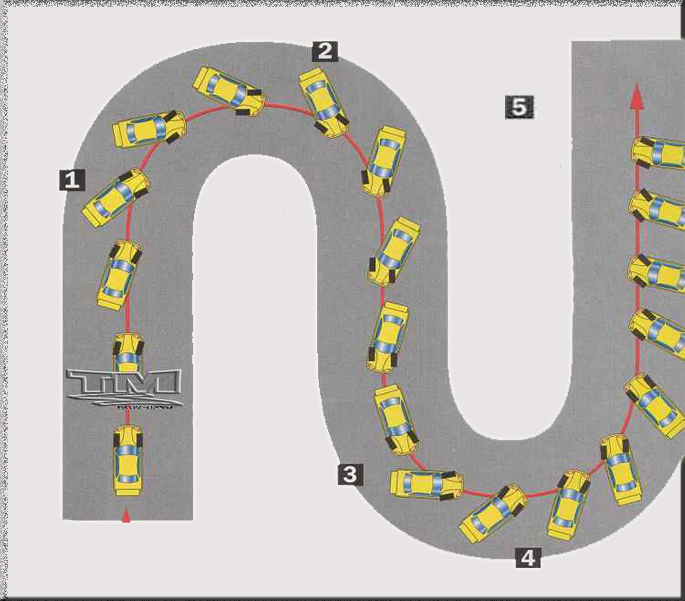The
Physics of Drifting
http://speedandlife.blog.gogo.mn/read/entry241110
 Drifting is a very difficult skill to learn when it
comes to knowing how to control a car. The picture
to the right represents how to go about
initiating and maintaining a drift. As a concept
overview, a brief explanation is relatively simple.
The red arrow represents the direction of motion
along the conceptual road. When approaching the
turn, steer into it to start the drift, and then
quickly steer the tires into the drift in order to
control the angle at which it travels around the
curve, and requires a delicate balance. In order to
drift any follow-up turns, the drift must be
maintained through the straight and then repeating
the previous action for the first curve to drift the
second curve
(speedandlife.blog). Finally coming out of the
last curve, the driver can either straighten out
their car, or instead, maintain the sideways drift
for as long as possible before straightening out,
which is often done in professional racing events
for maximum points.
Drifting is a very difficult skill to learn when it
comes to knowing how to control a car. The picture
to the right represents how to go about
initiating and maintaining a drift. As a concept
overview, a brief explanation is relatively simple.
The red arrow represents the direction of motion
along the conceptual road. When approaching the
turn, steer into it to start the drift, and then
quickly steer the tires into the drift in order to
control the angle at which it travels around the
curve, and requires a delicate balance. In order to
drift any follow-up turns, the drift must be
maintained through the straight and then repeating
the previous action for the first curve to drift the
second curve
(speedandlife.blog). Finally coming out of the
last curve, the driver can either straighten out
their car, or instead, maintain the sideways drift
for as long as possible before straightening out,
which is often done in professional racing events
for maximum points.
https://www.scienceabc.com/pure-sciences/science-of-drifting-how-does-drifting-a-car-work.html

When a drift
is done properly, the result will be similar to
what is shown to the left,
where the
car travels at an angle around the curve. Often,
as such is shown, in competition events many
drivers will be on the course at one time,
requiring a high level of skill and control
over the vehicle. Now, let's take a look more in
depth of the driving forces behind what allows a
vehicle to controlled drift around a curve.
Generally, the major force that affects a
car's drift is friction. Friction is one of the
most basic and important force known, which makes
everything in our lives work. Without friction we
could not walk or drive our precious cars.
https://www.scienceabc.com/pure-sciences/science-of-drifting-how-does-drifting-a-car-work.html
When going
around a turn, without friction, the car could not
change direction. Instead, it would
continue at
a tangential direction relative to the curve. This derives from Newton's
2nd Law, where
F=MA.
However, rather than the conventional notation for
acceleration, the proper form would be where
due to the fact that radial, or circular
acceleration, is the velocity squared over the
radius. Frictional force can be calculated
by ,
where
is the static coefficient of friction, and N is
the normal force due to gravity. So by assuming
that friction and gravity are the only forces
acting on the vehicle, we can then calculate what
force of friction must be overcome to make the car
drift at a constant velocity around a curve of a
given radius. By overcoming friction, the wheels
slip, and thus the car is allowed to drift.
|